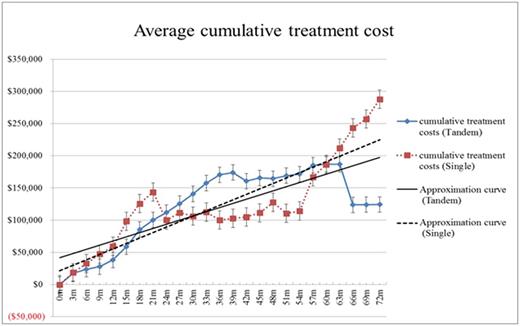Abstract
Introduction:
Autologous stem cell transplantation (ASCT) plays a major role in the treatment of multiple myeloma. However, the result of STaMINA trial showed no extra benefit of second transplantation or consolidation therapy in addition to single ASCT; there is still argue about the optimal intensity of the treatment in patients with high-risk cytogenetic abnormalities. We analyzed retrospectively, the effect of the tandem ASCT and the cost.
Methods:
We analyzed multiple myeloma patients with Adverse Cytogenetics who were treated with ASCT in National Center for Global Health and Medicine Hospital from January 2010 to the end of March 2017. Most patients were treated with bortezomib based induction therapy. Patients who failed to achieve very good partial remission or better after the first ASCT proceeded to the second ASCT. Most patients received consolidation therapy and/or maintenance therapy. Overall Survival (OS) and progression free survival (PFS) was analyzed using the Kaplan-Meier methods, and the log-rank test. Also, cumulative cost for the treatment was evaluated. Adverse cytogenetics were defined as hypodiploidy, del(17p), t(4;14), and t(14;16).
Results:
Ten patients were treated with tandem ASCT, and fifteen patients were treated with single ASCT. Twenty-one patients were treated with BD regimen, two patients with CyBorD regimen, and two patients with VAD regimen. The median number of induction therapy was 4 cycles (4-6). The PFS of the tandem ASCT group (3yrs PFS was 87.5%) was superior to the single ASCT group (3yrs PFS was 37.2%) (P = 0.0038). The OS of the tandem ASCT group (3yrs PFS was 100%) was superior to the single ASCT group (3yrs OS was 49.5%) without statistical significance (P = 0.057). We compared cumulative costs of tandem ASCT patients with single ASCT patients. We plotted the average cumulative cost of every 3 months in each group. The first 21 months and beyond 54 months, the rate of cost increment was apparently higher in the single ASCT group than tandem ASCT group. A regression line was calculated for the average cumulative cost of single ASCT group and tandem ASCT group. Regression analysis revealed that overall inclination of the regression line of the cost in single ASCT was significantly larger than that of the cost in tandem ASCT (P = 0.0024).
Conclusion:
The outcome of tandem ASCT was superior to single ASCT in patients with adverse cytogenetics. Also, the total cost in patients with tandem ASCT was lower than that with single ASCT. Tandem ASCT may reduce the rate of relapse and the cost for salvage treatment. Therefore, tandem ASCT should be considered for multiple myeloma patients with adverse cytogenetics from a cost-benefit point of view.
No relevant conflicts of interest to declare.
Author notes
Asterisk with author names denotes non-ASH members.


This feature is available to Subscribers Only
Sign In or Create an Account Close Modal